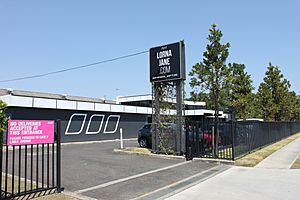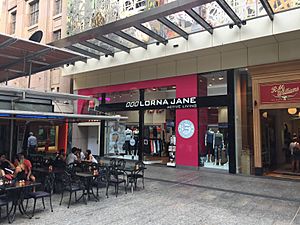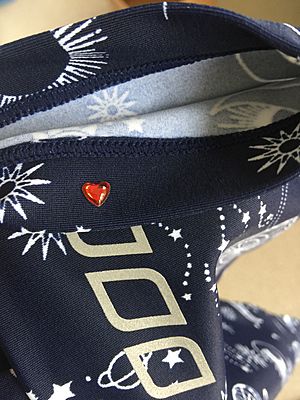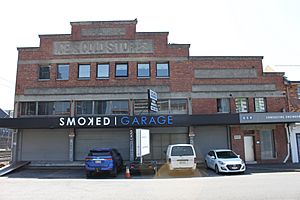Lorna Jane facts for kids
 |
|

Headquarters at Eagle Farm
|
|
| Private | |
| Industry | Retail |
| Founded | 1990 |
| Founder | Lorna Jane Clarkson and Bill Clarkson |
| Headquarters |
,
Australia
|
|
Key people
|
Lorna Jane Clarkson (Founder & Chief creative officer) Bill Clarkson (CEO) |
| Products | Athletic apparel |
| Revenue | AUD$ 200 million (2014) |
| AUD$ 19.6 million (2013) | |
| Total equity | AUD$ 500 million (estimated) (2016) |
| Owners |
|
|
Number of employees
|
1,800 (2015) |
Lorna Jane is a company that sells athletic clothes. Its main office is in Brisbane, Australia. It also has offices in the United States, Singapore, China, and New Zealand. Lorna Jane Clarkson and her husband, Bill Clarkson, started the company in 1990. This brand, which makes activewear for women, has 134 stores. These stores are located in Australia, New Zealand, the United States, and Singapore. Lorna Jane also has stores run by other companies in places like New Caledonia, Mexico, Europe, Dubai, and Malaysia.
Contents
What Lorna Jane Sells
Lorna Jane makes and sells many different types of clothing. These include tights, sports bras, tops, shorts, pants, jackets, and hoodies. They also sell shoes and various accessories. Many of their items use a special fabric called "LJ Excel." This fabric helps to pull sweat away from your body and stretches in four directions. Other clothes use special fabrics that hug your body or have "power mesh" panels. A magazine called Marie Claire even said Lorna Jane was one of the best eco-friendly sports brands.
Special Collections
The company sometimes releases special, limited-edition clothing lines. These have included collections for pregnant women. They also had a "Little Miss" range for babies and young children.
The Love Bead
Every piece of Lorna Jane clothing has a small, heart-shaped bead sewn into it. This bead is a special message to customers. It means that the clothing was made "with love." The company names its clothing styles after people who work at Lorna Jane. One team member said it feels like Christmas morning to see their name on a new style!
Clothing Sizes
When Lorna Jane first started, their clothes came in sizes up to "L." In 2014, they added "XXS" and "XL" sizes. Lorna Jane Clarkson has explained that the company focuses on the sizes their customers ask for most.
In 2015, an Australian consumer group called Choice tested Lorna Jane tights. They compared them to similar tights from six other brands. Some of the cheaper brands performed better in certain tests. However, an expert in textiles praised the Lorna Jane tights for how well they were made. They also scored better in tests for stretch, stains, and stitching.
Awards and Recognition
Lorna Jane has won many awards for its designs, totaling 13 awards. They have also won several marketing awards. In 2017, Marie Claire magazine readers voted Lorna Jane as the "Best Athleisure Brand."
How Lorna Jane Makes Clothes
Lorna Jane's website states that the brand is dedicated to using eco-friendly methods. This includes how they make and get their materials. They have worked with their main clothing factory for more than 25 years.
The company is proud of the good working conditions for its factory employees. They say that very few workers do not return after the Chinese New Year holiday. This is much better than other factories in the area. Workers sometimes call the factories "Lorna Land." Lorna Jane's production meets WRAP Gold Certified standards.
Lorna Jane Clarkson has said she would prefer to make clothes in Australia. However, she explained that Australian fabric factories closed down. Also, there was not enough government help for the clothing industry. This made it impossible to keep making clothes in Australia.
No Men's Clothing
Even though people ask "two or three times a week," Lorna Jane Clarkson has no plans to make activewear for men. She once said she prefers men to wear "their old footy shirts and triathlon shorts."
Lorna Jane's Story
How It Started

The founder, Lorna Jane Clarkson (whose maiden name was Smith), used to be a dental technician. She also taught aerobics part-time. In the late 1980s, she was not happy with the workout clothes available. So, she started making her own. Her designs became very popular with her students. They asked her to make clothes for them too.
In 1988, she decided to make clothes full-time. She and her partner, Bill Clarkson, found it hard to get stores to sell their clothes. So, they decided to sell them themselves. In 1990, they opened their first store. It was on an upper floor of the Broadway on the Mall shopping center in Brisbane.
By 2000, the business needed a bigger factory. To pay for this, the Clarksons sold their home. They bought a building in Fortitude Valley for $465,000. They fixed it up, and within two years, the building was worth $4 million. The Clarksons used this increased value to help their business grow even more.
The company's logo has three diamond shapes. Each shape has two curved corners. This design represents a stylish "L" and "J" joined together.
Growing the Business
The company was able to use the 2008 financial crisis to its advantage. Instead of waiting for the economy to get better, Lorna Jane kept growing. They found good locations for stores that they might not have been able to get before. This plan led to the company's biggest period of growth.
In 2010, a company called CHAMP Ventures bought 40% of Lorna Jane.
After the 2010–11 Queensland floods, Lorna Jane started a charity program. Customers could trade in used activewear (from any brand) for store credit. The used clothes were then given to the Salvation Army. This "Swap Shop" program was meant to last a week in 2011. But it became a permanent program and was still running years later. By 2017, customers had brought in over 45,000 garments for charity.
In March 2012, Lorna Jane opened its first store in the US. It was in Malibu. At a time when many people were shopping online, Lorna Jane decided to open more physical stores. By mid-2013, a new Lorna Jane store was opening in California every three weeks. The Clarksons chose California because the active lifestyle there was similar to Australia.
In August 2012, Lorna Jane launched a fitness tracking app.
By 2013, the company had a 9.4% share of all athletic clothing sales in Australia. The company's sales grew by more than 40% each year between 2008 and 2013. In the same year, the company started "Active Living Rooms." The first one opened in Teneriffe, Queensland. They also launched a stylish clothing line called "Uniquely." This line blended activewear with everyday casual clothes.
2014 Developments
In early 2014, the Clarksons and CHAMP thought about selling shares of the company to the public. This is called an initial public offering (IPO). However, they decided not to go through with it. They wanted to keep control of their brand.
In March 2014, Lorna Jane started working with big department stores. In Australia, they partnered with David Jones. In the US, they partnered with Nordstrom. This meant Lorna Jane clothes were sold inside these larger stores.
In July 2014, a petition was started online asking Lorna Jane to add larger sizes. The petition received many signatures. As a result, the brand added a new size, XL.
In August 2014, the company started publishing a magazine. It was called Active Living and was available in their stores every six weeks. Also in August 2014, Lorna Jane began officially registering its clothing designs. This was to help protect them from others copying their unique styles.
See also
- List of companies named after people




